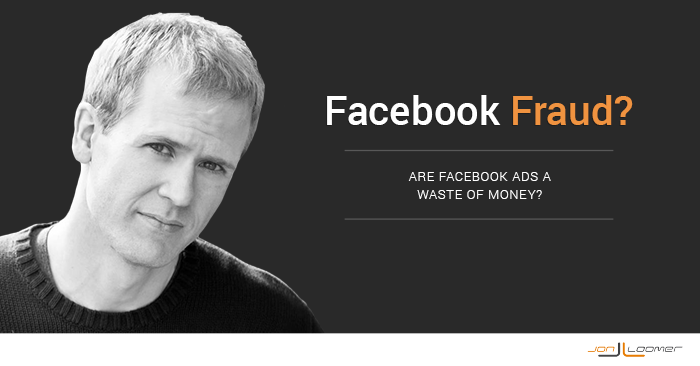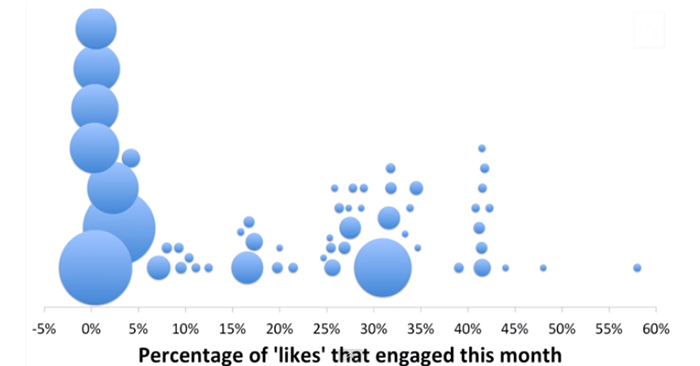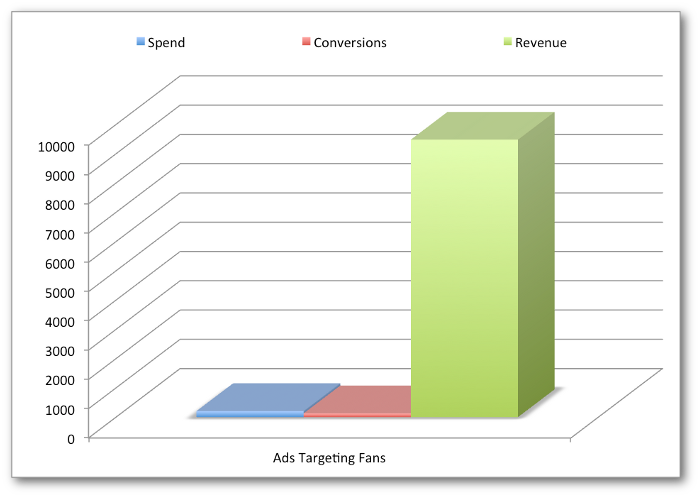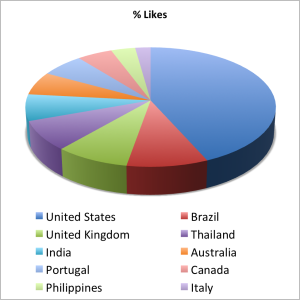
[AUDIO VERSION: As an experiment, I also recorded an audio version of this blog post. Click below to listen. Let me know if this is something you find helpful!]
You’ve undoubtedly seen the following video from Veritasium called “Facebook Fraud.” If you haven’t yet, please watch it below…
It’s a well produced video put together by a very smart guy outlining why Facebook ads are a waste of money. He cited three main examples why, and I’ll dig into those in a minute.
Not surprisingly, I’ve had dozens of people send me this video. If nothing else, I’m beyond impressed by their ability to create a viral video (and of course, I’m contributing to that now!).
I’m not writing this post to rip apart the video’s author or to say it’s entirely wrong. He represents a viewpoint that is very common, and it’s something that deserves to be heard and addressed.
While I disagree with the conclusion, that doesn’t make the video itself false.
Given the response the video has gotten — and the repeated questions I’m getting about it — I felt it was important I respond in some way. So in this post, I’m going to do the following:
- Recap the major points of the video
- Explore common ground
- Voice my issues with the video
- Provide my own stats and history with Facebook ads
The Facebook Fraud Video
The video addresses three main examples…
First, the Virtual Bagel experiment from 2012.
Remember this? BBC Technology correspondent Rory Cellan-Jones created this useless Facebook page to test the value of a page like. He intentionally created a page with (hopefully) no value to find out whether you could still use ads to generate fans.
After paying $100 for ads, the page ended up with more than 3,000 fans (there are more than 4,000 a year and a half later). His ads were targeted at users in the United States, United Kingdom, Russia, India, Egypt, Indonesia, Malaysia and the Philippines (note that the video doesn’t mention Russia, India or Malaysia).
Per Cellan-Jones’ article in 2012, here is the extent of targeting:
I narrowed it down slightly by targeting under 45-year-olds interested in cookery and consumer electronics, but was told that would still give me a potential audienceThis is the group of people who can potentially see your ads. You help influence this by adjusting age, gender, location, detailed targeting (interests and behaviors), custom audiences, and more. More of 112 million customers.
Virtually nobody in the US or UK liked his page. When broadly targeted, the ad received a click-through rate of 0.55%. When narrowed to only the UK, that percentage dwindled to 0.059%.
This underscored the problem with targeting at particular countries, raising doubts about the quality of fans there.
Second, Facebook Advertising for the Veritasium page.
At the 2:07 point, the author of the video continues…
So did they delete all of the fake likes? Nope. Not even close. I know because most of the likes on my Facebook page are not genuine.
He explains how in May of 2012, he received emails from Facebook with a $50 coupon code to try Facebook ads. So he did.
As he started running ads, his audience grew exponentially. He went from 2,000 fans to more than 130,000 today (though it sounds like he had just over 100,000 related to the study).
He found that as his audience grew, engagement did not. If fact, he felt as though engagement may have even declined.
Make sure to check out his graph at the 3:13 point where he notes that 80,000 of his likes (or what he says is 75%) come from developing countries. This results in 1% of his page’s engagement.

At the 5:20 point:
I should reiterate, I never bought fake likes. I used Facebook’s legitimate advertising.
He is never clear about the targeting of this ads. But since he doesn’t make claims to the contrary, the argument appears to be that ads broadly targeted at these countries brought meaningless likes that didn’t result in engagement.
Finally, the Virtual Cat experiment.
The author of the video then decided to run his own experiment. So he created another useless Facebook page called Virtual Cat. He then spent $25 targeting cat lovers in the US, UK, Canada and Australia.
The result of that $25: 262 page likes. While details weren’t provided, he says that many of the likes were from people liking thousands of pages.
He also referred to a single post that he published on a Friday afternoon that reached only eight people and received no “engagement” (defined in this case, apparently, as comments, likes and shares).
On Click Farms
Early in the video, it’s mentioned that Facebook likes can be bought in two ways: Legitimately and illegitimately. You can “buy” them through ads or pay click farms and break Facebook’s rules.
The video describes how you can buy 1,000 likes for $70, and that workers are paid $1 for every 1,000 like clicks. These services have users set up in countries like India, the Philippines, Nepal, Sri Lanka, Egypt, Indonesia and Bangladesh.
Note that the “legitimate” way of buying likes is through Facebook ads. But in the examples this video provides from 2012, those ads were targeted at countries known for click farms.
Some pages do this intentionally to bulk up their likes. Some do it unknowingly. In 2012, I suspect they innocently paid for these ads thinking they were getting quality fans.
These days, of course, we know better.
Where We Agree on Concerns
While I have issues with the conclusions of the video, what he shared does underscore a very real problem. Even in the US, UK, Canada and Australia, remnants of these click farms exist.
And as I outlined when Optimized CPM first came out, the problem is that Facebook is going to target your ad at people most likely to perform your desired action. In some cases, that could be at people who have liked thousands of pages.
Granted, that is mitigated quite a bit with proper targeting (not just by country), but fake profiles still exist.
My Issues with the Video
Let me go point by point on my major issues with the video before I get to my own stats.
Again, I appreciate the video and the conversations it starts. But a different perspective from someone who has seen incredible success with Facebook ads is necessary.
The Core of the Argument is Based on Results from 2012
We’ve been through this regarding the Virtual Bagel page before. This is old news.
The Facebook ad feature set has changed significantly since then. These features either didn’t exist or were unlikely to be used during these tests:
- Conversion Tracking
- Custom Audiences
- Lookalike Audiences
- Website Custom Audiences
- FBX
- Partner Categories
- Facebook’s new ad reports
If you still use Facebook ads as if it’s 2012, you deserve the results you get.
I felt it strange that so much of the video was focused on something so long ago. We should have learned our lessons since then. If you target well (and use Power Editor), you’re much more likely to find success.
The fact that poorly targeted ads in 2012 didn’t work shouldn’t be a surprise. The two examples weren’t the only ones. I’m included among those who screwed up (see later in this post about my stories).
About Those Click Farms…
The video talks about how click farms are prevalent in countries like India, the Philippines, Nepal, Sri Lanka, Egypt, Indonesia and Bangladesh.
Remember that Virtual Bagel experiment? It was considered an indictment on Facebook ads because no one in the US or UK clicked on the ad while also targeting and getting likes from India, Egypt, Indonesia, Malaysia and the Philippines.
We as readers and viewers should completely understand why that page ended up with a bunch of undesirable likes. It targeted users in countries that are known to be a problem.
And shouldn’t the fact that so few people from the US and UK liked a worthless page be an indication that targeting in those countries may actually be okay?
I guess the argument is that those click farms are a problem and shouldn’t exist. Well, that’s true. But by now, we should all know they exist, and we should also know how to avoid them the best we can.
The author goes on to say that this is reflected in his own page, which is littered with fake likes. He provides a graph showing that 80,000 of his fans were from undesirable countries who provided less than 1% of his engagement.
Again, he isn’t clear here, but it sounds like he targeted ads at these countries. If he didn’t, I fully expect he would have made a very strong point to the contrary.
You get what you pay for. Yes, click farms exist. Yes, some countries are much less desirable than others. You should expect the quality of your audience to follow.
Small Sample Sizes
The most compelling argument was one built on the smallest of sample sizes: The $25 in ads for Virtual Cat.
I wish he would have done more here. I wish he would have spent more money and provided more details regarding the number of fans who liked X number of pages.
This is a phenomenon I have seen before, so I don’t doubt that it can happen. But I would have loved to see more details on how bad it was in his experiment. It just isn’t clear, which weakens the overall argument of the video.
Targeting
We’ve established that poorly targeted ads will get you nowhere. This is precisely why I repeatedly tell you not to use the quick fix ads tools of Boost Post and Promote Page. Use Power Editor.
You no longer need to broadly target a country based on age and gender (recall that the Virtual Bagel ad targeted 112 Million people!). You can target based on the basic things like interests and even buying histories (Partner Categories).
But do you know how you can really avoid any of these issues? Focus most of your budgetA budget is an amount you're willing to spend on your Facebook campaigns or ad sets on a daily or lifetime basis. More on the people you know care about your brand.
That’s why I talk about targeting your email list with Custom Audiences and targeting your website visitors with Website Custom AudiencesA website custom audience matches people who visit your website with people on Facebook. You can then create ads to show to that audience. More (and previously with FBX).
If You Target Ads Poorly, They Won’t Work
None of the conclusions should be a surprise here.
If you target countries that aren’t relevant to you and are known to be havens for click farms, you will end up with a bunch of worthless likes. This isn’t 2012 anymore. You can no longer play ignorant to this.
Likewise, if you target ads very broadly at “cat lovers” don’t expect to get high quality fans. In fact, don’t expect any actual “cat lovers” to respond when you create a completely unrelated post about a scientific experiment.
Your most relevant audience is your actual customers. When you create Facebook ads, you start with them. The further you get away from that center, the less confidence you should have in the results.
Luckily for you, there are plenty of ways to target a highly relevant audience instead of blindly targeting click farm countries and broad, fluffy interests.
If Facebook Ads Don’t Work…
Let’s assume for a minute that this video is correct. Paying for Facebook ads is a complete waste of money.
I guess we also first have to assume that Facebook ads are only used for getting likes. But stick with me…
My entire Facebook strategy is based on building a relevant audience — largely through ads. If what I was paying for was only fake profiles, this would be obvious.
How would it be obvious? Well, I wouldn’t get anyone to opt in to my newsletter. Or register for my webinar. Or — most importantly — buy my stuff.
But my strategy is based on the importance of building that highly relevant audience. You can’t sell up front. You attract the right crowd. So when you’re ready to sell, you do use ads — but you target your fans.
My results?
Yes, Facebook Ads Work

I’ve seen first hand that Facebook ads work. They drive website traffic, build my email list and produce sales.
In fact, I’ve found repeatedly that it’s a highly relevant fan base that produces these things. Read these posts:
- How I Got 35X ROI on Facebook Ads
- How an Online Facebook Offer Targeted at Fans Resulted in 9.5X ROI
- Why You Shouldn’t Forget About Facebook’s Sidebar [Research]
[NOTE: I included the last blog post because it details my Cost Per Registration and Cost Per Sale by placementA placement is a location where your ad is shown. Examples include Facebook's mobile Feed, Messenger, Instagram feed, Audience Network, right-hand column, and more. More.]
If my fan base — built largely through ads — was built with bots, this would not be possible.
My Stats and History with Facebook Ads
I think it’s only fair that I share some of my stories and the breakdownBreakdown is a way to get insights into your ad performance related to time, delivery, action, or dynamic creative element. More of my own audience.
I am someone who has spent more than $12,000 on Facebook ads for my page since the start of 2013, and I am now routinely spending more than $2,000 per month.
But know that I’m just like anyone else. I didn’t fully understand all of the features when they were rolled out. I didn’t know of the pitfalls of poorly targeted ads in the beginning — and the targeting was not always all that good anyway.
As a result, I can include my name on the list of advertisers who regretfully paid for ads that weren’t nearly as successful as they thought they were at first glance. And some of those fans undoubtedly still like my page.
Here is a breakdown of my fan base in order of country (including top 10 only, which makes up about 80% of the total).

- United States – 34.47%
- Brazil – 7.53%
- United Kingdom – 6.88%
- Thailand – 6.46%
- India – 5.70%
- Australia – 5.01%
- Portugal – 4.97%
- Canada – 4.04%
- Philippines – 2.78%
- Italy – 1.76%
Recall that the video talked of a page being overrun with likes from click farm countries (75% of likes). I’m not getting that, as you can see, even though I spend quite a bit of money on ads. But I do have about 15% wrapped up in Thailand, India and the Philippines.
I can attribute a decent portion of that to lessons learned with targeting. In the beginning, I just assumed that if someone liked my page, they actually liked it — it didn’t matter where they were from.
Later, I would promote posts to people outside of my core countries thinking something similar — I was just looking for website traffic. Of course, many of those people liked my page, too.
Lessons learned, and these days I target almost exclusively the United States, United Kingdom, Australia and Canada. I do hate this because I know that business exists outside of these countries, but I also need to be careful.
Now, I’m not sure how the graph was made in the video to determine where fan engagement came from, but note that Facebook doesn’t break down engagement via fans and non-fans by country. I am going to assume he was referring to the People Talking About This by Country metric within Insights (note that this leaves out all sorts of good engagement, however).
Here are my top engagement countries by Talking About This over the most recent 28-day period (this makes up 83% of my Talking About This).
- United States – 45.98%
- United Kingdom – 12.38%
- Australia – 6.99%
- Canada – 5.28%
- Ireland – 3.46%
- India – 3.27%
- New Zealand – 1.74%
- Brazil – 1.72%
- Israel – 1.25%
- Italy – 1.14%
Now, if you’re following and you’re smart, I know exactly what you’re thinking: “Where are Thailand and the Philippines? And what’s the deal with Brazil? Doesn’t this partly prove the point of the video?”
Well, remember that I also advertise quite a bit these days. And as I said, I target the top four countries in these results almost exclusively. Since these stats don’t separate fans from non-fans or paid from organic, it’s really hard to make any sense of the numbers.
So the Talking About This numbers coming from all but the top four countries is organic only (or nearly organic only). That tells me that the fans in India, though I don’t doubt issues, have some value.
Is it possible that my audience from India, Thailand and the Philippines are horribly engaged compared to other countries? It is. But we already know the issues with these countries, and I seem to have that under control.
Yes, There’s a Problem, But Mitigate It
Those who watch that video will likely walk away into one of three groups:
- It validates their lack of success with Facebook ads
- It proves that those who take shortcuts will fail
- It’s a cautionary tale
The first two groups already know where they stand. I’m hoping to help the third group understand that they can find success with Facebook ads. They just can’t take shortcuts.
I will not deny that there is an issue with fake profiles, bots and spam accounts on Facebook. There is a problem. When you spend money on ads to get likes, you expect them all to be real people.
Facebook does need to clean this up the best they can. But understand that the problem is not unique to Facebook. And it’s a problem that will never be completely eliminated.
Your job as an advertiser is to understand the environment. Undesirable people and accounts are everywhere. They are a minefield. You need to avoid them and reachReach measures the number of Accounts Center Accounts (formerly users) that saw your ads at least once. You can have one account reached with multiple impressions. More the people most likely to care about your brand.
Because Facebook’s ability to target is so powerful, you have more tools than the typical marketer to do just that. If you ignore these tools — or are unable to use them properly — you will fail. You will not get value out of your fan base. You will not build your email list. You will not profit.
It’s up to you whether you’d like to put in the effort.







